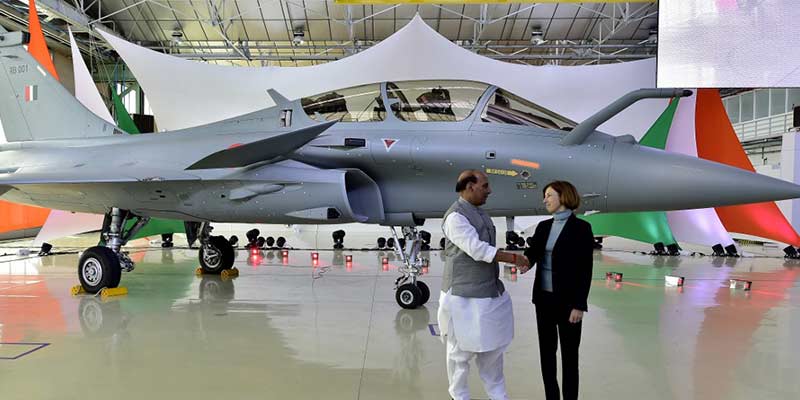- India
- Oct 09
Rajnath receives India’s first Rafale jet
The Rafale multi-role fighter jets will boost India’s air dominance exponentially, Defence Minister Rajnath Singh said as he took delivery of the first of the 36 French-made aircraft acquired by the Indian Air Force.
Singh attended the handover ceremony along with his French counterpart Florence Parly at the Dassault Aviation facility in Merignac.
The RB001 Rafale, denoting the initials of Air Chief Marshal Rakesh Bhadauria who played a key role in striking the deal for the jets in his role as IAF deputy chief, was unveiled with the Indian tricolour as its backdrop.
The Rafale jets will come with various India-specific modifications, including Israeli helmet-mounted displays, radar warning receivers, low band jammers, 10-hour flight data recording, infrared search and tracking systems, among others.
India had ordered 36 Rafale fighter jets from France in a deal worth Rs 59,000 crore in September 2016.
The first batch of four Rafale jets will fly to their home base in India by May 2020. All 36 jets are expected to arrive in India by September 2022, for which the IAF has been reportedly undertaking preparations, including readying infrastructure and training of pilots.
Categorised as a 4.5 generation aircraft for its radar-evading stealth profile, the Rafale is expected to be a game-changer for the IAF, as most of its aircraft are either third or fourth-generation fighters.
India will only be the fourth country after France, Egypt and Qatar to fly the Rafale.
What is the Rafale?
* Introduced in 2001, Rafale is a twin-engine, canard-delta wing, multi-role combat aircraft designed and built by French company Dassault Aviation. The aircraft is regarded as one of the world’s most potent combat jets.
* The fighter jet, armed with a wide range of weapons, is designed to perform air supremacy, interdiction, aerial reconnaissance, ground support, in-depth strike, anti-ship strike and nuclear deterrence missions.
* The aircraft is fitted with an onboard oxygen generation system (OBOGS), which suppresses the need for liquid oxygen refilling or ground support for oxygen production.
* It is capable of carrying out a wide range of missions, including air defence / air superiority, reconnaissance, close air support dynamic targeting, air-to-ground precision strike / interdiction, anti-ship attacks, nuclear deterrence and buddy-buddy refuelling.
* It is distinct from other European fighters of its era, as it is almost entirely built by one country, involving most of France’s major defence contractors such as Dassault, Thales and Safran.
* Many of the aircraft’s avionics and features, such as direct voice input, the RBE2 AA active electronically scanned array (AESA) radar and the optronique secteur frontal infra-red search and track (IRST) sensor were domestically developed and produced for the Rafale programme.
* The aircraft is available in three main variants: Rafale C single-seat land-based version, Rafale B twin-seat land-based version and Rafale M single-seat aircraft carrier-based version.
Why does India need the Rafale?
* India felt the need to revamp the IAF’s fleet by introducing multi-role combat aircraft, considering the prevalent security environment.
* After the Kargil experience, the armed forces and the defence ministry were of the opinion that the IAF’s combat ability to strike targets required radical improvement.
* The defence ministry came to the conclusion that an aircraft adds to the combat strength of the forces only when it is loaded with the requisite weaponry, which enables it to strike targets. This need was first recorded in 2001.

